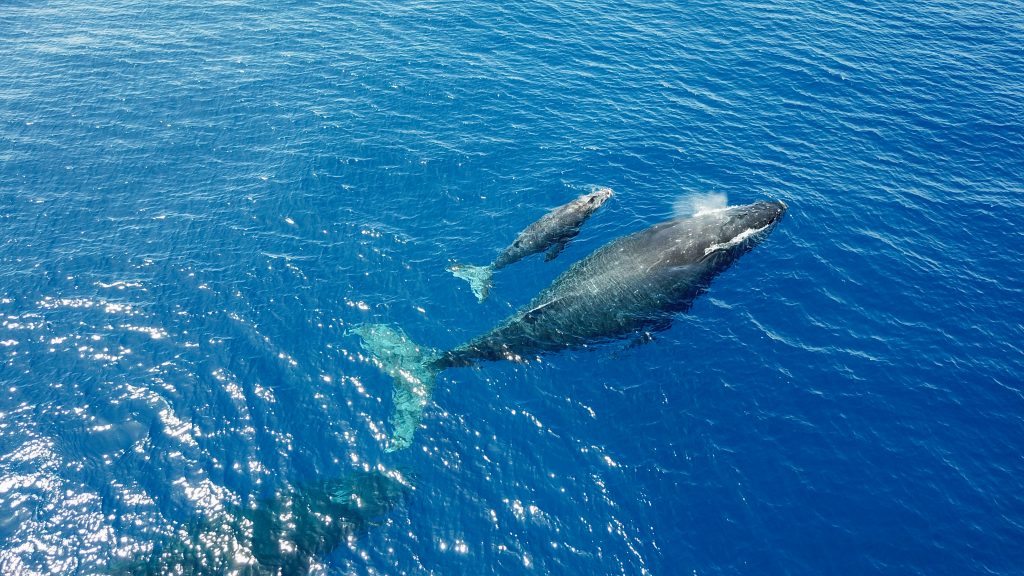Whale Week Trivia: How many whales are in Hawaiʻi each year?

February 14-20th, is “Whale Week” with Sunday, February 20th being “World Whale Day”
On Sunday, Feb. 20,2022, the Hawaiian Islands Humpback National Marine Sanctuary hosts a special outreach event at the Maui Ocean Center, with free whale posters, kid’s whale activity books and a special “Whale Selfie” station.
Here’s some interesting whale trivia about the wintering whales that come to Hawaiʻi each year to breed, give birth, and nurse their young.
How many whales are in Hawai‘i each year?
Answer: Humpback whales were plentiful in oceans worldwide before the global population was depleted by commercial whaling at the start of the 20th century. In 1993 it was estimated that there were 6,000 whales in the North Pacific Ocean, and that 4,000 of those came to Hawaiʻi. Today, the population of humpback whales that uses Hawaiʻi’s waters as their principle wintering ground is likely more than 10,000 animals. This number is based on a comprehensive research effort that occurred between 2004 and 2006 that estimated the population at approximately 10,000 animals, and the likelihood that the population is still increasing at some unknown rate.
Where in the world can we find humpback whales?
Answer: Humpback whales are found in most of the world’s oceans. Most of them follow a regular migration route, spending their summers in temperate and polar waters for feeding and spending their winters in tropical waters for mating and calving. The one exception is in the Arabian Sea where a year-round, non-migratory population lives.
Researchers are able to identify individual whales. We as humans are identified by our fingerprints. How would one identify different humpback whales?
Answer: Each humpback whale has a unique pattern on its fluke (tail). The underside of the tail fluke can be from all white to all black and is unique to each humpback. In addition to the pattern, the serrated edge of the fluke is also unique to each whale. Through careful study, the fluke pattern can be used to identify individual whales.
Humpback whales do not have teeth. In order to feed, what do they use?
Answer: They have baleen plates instead of teeth. A baleen whale has a series of 270-400 fringed overlapping plates that hang from each side of the upper jaw. These plates consist of fingernail like material that frays out into fine hairs on the ends. When the whale feeds, it takes in large volumes of water that passes through the baleen plates and strains its food from the water.
The mouth of the humpback whale is about 1/3 the size of the body. How big is the tongue?
Answer: Humpback whales have a tongue that is about the size of Volkswagen bug! Interestingly, the opening at the back of the throat is about the size of a grapefruit, which means that a humpback whale would still have a hard time swallowing a large fish.
How big is the average humpback whale?
Answer: Adult male humpback whales measure 38-42 feet in length and females are slightly larger, measuring 40-45 feet. For comparison, an average school bus is about 45 feet long.
Approximately how much do humpback whales eat a day during the feeding season?
Answer: It is estimated they eat an average of about 1 to 1.5 tons of krill and small fish per day during the summer months in the cold, nutrient rich waters of Alaska.
Who are the humpback whales’ predators?
Answer: Killer whales are the main predators of humpback whales, although sharks have been known to attack young, sick or dead whales.
What are some human activities that can harm humpback whales?
Answer: Humpback whales face various anthropogenic threats, including the potential of getting hit by boats and entanglement in nets and gear or other marine debris. There is also research on how noise in the water affects humpback whales.
By regulation, humpback whales cannot be approached closer than ____yards.
Answer: All ocean users, including swimmers, snorkelers, divers, kayakers, jet skiers, boaters, windsurfers, or surfers should not approach a humpback whale closer than 100 yards (90 meters). Do not chase, closely approach, surround, swim with, or attempt to touch humpback whales. To report an approach violation or other incidences of humpback whale disturbance, please call the NOAA Office of Law Enforcement’s 24-hour hotline at 1-800-853-1964.

*Courtesy: Hawaiian Islands Humpback Whale National Marine Sanctuary









